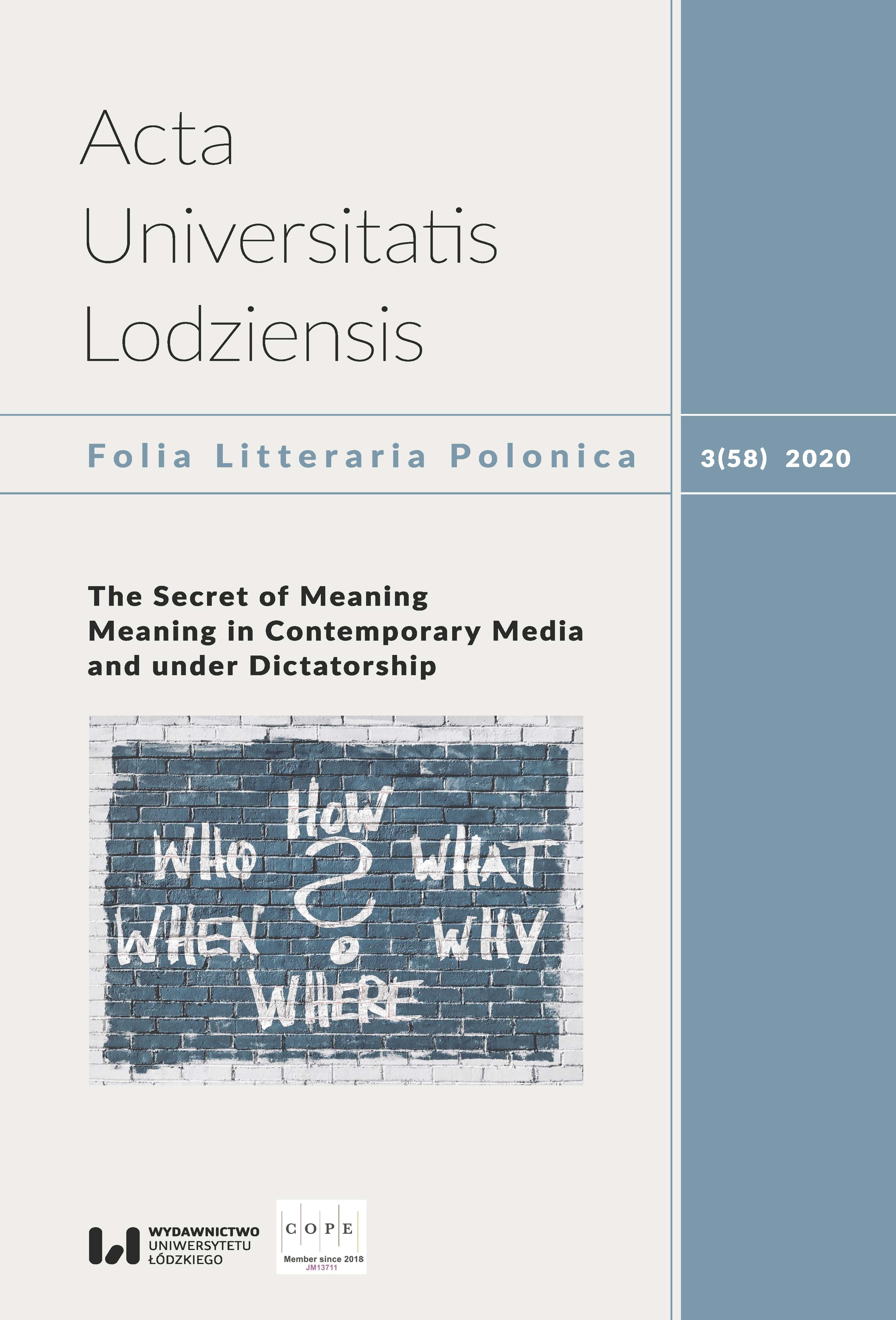Tajemnice ASMR – perspektywa ogólna i lingwistyczna
DOI:
https://doi.org/10.18778/1505-9057.58.17Słowa kluczowe:
ASMR, neurobiologia, zmysły, synestezja, fonetyka, onomastyka, medionimy, konceptualizacja, dyskurs, funkcje językaAbstrakt
Artykuł prezentuje zjawisko ASMR (Autonomous Sensory Meridian Response, tłum. pol. samoistna odpowiedź meridianow czuciowych) z perspektywy ogólnej i lingwistycznej. Definicja pojęcia i zreferowanie stanu badań stanowią wprowadzenie do klasyfikacji wyzwalaczy ASMR ze względu na zmysły stanowiące źródło doświadczania tzw. efektu ASMR. Autor przedstawia argumenty za włączeniem dotyku i zapachu do klasyfikacji wyzwalaczy. Lingwistyczna analiza zjawiska koncentruje się wokół fonetycznych właściwości wyzwalaczy głosowych, aspektów onomastycznych – analiza gramatyczna i konceptualna wyodrębnionych 17 klas medionimów (nazw kanałów ASMR) oraz dyskursu jako przestrzeni, w której realizowane są funkcje – fatyczna i socjalizująca (budujące więź w obrębie społeczności ASMR; ich realizacja leży po stronie artysty ASMR) oraz ewaluatywna i perswazyjna (ich realizacja leży po stronie odbiorców nagrań).
Pobrania
Bibliografia
Ahuja A., Ahuja N.K., „Clinical Role-Play in Autonomous Sensory Meridian Response (ASMR) Videos Performance and Placebo in the Digital Era”, JAMA 2019, nr 321(14), s. 1336–1337, https://doi.org/10.1001/jama.2019.2302
Google Scholar
DOI: https://doi.org/10.1001/jama.2019.2302
Ahuja N.K., „‘It feels good to be measured’: clinical role-play, Walker Percy, and the tingles”, Perspectives in Biology and Medicine 2013, nr 56(3), s. 442–451, https://doi.org/10.1353/pbm.2013.0022
Google Scholar
DOI: https://doi.org/10.1353/pbm.2013.0022
Awdiejew A., Gramatyka interakcji werbalnej, Kraków 2004.
Google Scholar
Awdiejew A., Pragmatyczne podstawy interpretacji wypowiedzeń, Kraków 1987.
Google Scholar
Barratt E.L., Davis N.J., „Autonomous Sensory Meridian Response (ASMR): a flow-like mental state”, PeerJ 3 2015, e851, https://doi.org/10.7717/peerj.851
Google Scholar
DOI: https://doi.org/10.7717/peerj.851
Chudzicka A., „Potrzeba afiliacji i otrzymywane wsparcie społeczne u osób bezrobotnych”, Chowanna 1998, nr 1, s. 60–68.
Google Scholar
Cruttenden A., Gimson’s Pronunciation of English, London and New York 2013.
Google Scholar
Drabik B., Komplement i komplementowanie jako akt mowy i komunikacyjna strategia, Kraków 2004.
Google Scholar
Fredborg B., Clark J., Smith S.D., „An Examination of Personality Traits Associated with Autonomous Sensory Meridian Response (ASMR)”, Front. Psychol., 23.02.2017, 8:247, https://doi.org/10.3389/fpsyg.2017.00247201
Google Scholar
DOI: https://doi.org/10.3389/fpsyg.2017.00247
Garro D., „Autonomous Meridian Sensory Response – from Internet subculture to audiovisual therapy”, [w:] Proceedings of the Electronic Visualisation and the Art. Conference, 2017, s. 395–402, https://dx.doi.org/10.14236/ewic/EVA2017.79
Google Scholar
DOI: https://doi.org/10.14236/ewic/EVA2017.79
Grzegorczykowa R., Wstęp do językoznawstwa, Warszawa 2010.
Google Scholar
Grzegorczykowa R. et. al., Gramatyka współczesnego języka polskiego: morfologia, Warszawa 1999.
Google Scholar
Gut M., Marchewka A., „Funkcjonalny rezonans magnetyczny – nieinwazyjna metoda obrazowania aktywności ludzkiego mózgu”, [w:] Konferencja „Nowe metody w neurobiologii”, Warszawa 2004, s. 35–40.
Google Scholar
Harpaz Y., Levkovitz Y., Lavidor M., „Lexical ambiguity resolution in Wernicke’s area and its right homologue”, Cortex 2009, nr 45(9), s. 1097–1103.
Google Scholar
DOI: https://doi.org/10.1016/j.cortex.2009.01.002
Hill-Bator A., Pyziak A., „Znaczenie filtra światła niebieskiego w soczewkach wewnątrzgałkowych stosowanych w chirurgii zaćmy”, Ophtatherapy 2015, nr 2(2), s. 143–147.
Google Scholar
Janik McErlean A.B., Banissy M.J., „Assessing Individual Variation in Personality and Empathy Traits in Self-Reported Autonomous Sensory Meridian Response”, Multisensory Research 2017, nr 30(6), https://doi.org/10.1163/22134808-00002571
Google Scholar
DOI: https://doi.org/10.1163/22134808-00002571
Knill Ch., Dotyk i komunikacja. Wyd. 2 zm., Warszawa 2009.
Google Scholar
Kołomyjski D., „Fenomen zabijania w grach komputerowych”, [w:] Człowiek w świecie rzeczywistym i wirtualnym. Wybrane patologie społeczno-wychowawcze w cyberprzestrzeni, red. A. Andrzejewska, J. Bednarek, S. Ćmiel, Józefów 2013, s. 251–263.
Google Scholar
Komorowska E., Pragmatyka dyrektywnych aktów mowy w języku polskim, Szczecin–Rostock 2008.
Google Scholar
Kress G., van Leeuwen T., Reading Images: The Grammar of Visual Design, 2nd ed. London–New York 2006.
Google Scholar
DOI: https://doi.org/10.4324/9780203619728
Langacker R., Concept, image, and symbol. The cognitive basis of grammar, Berlin–New York 1991.
Google Scholar
Lochte B.C., Guillory S.A., Richard C.A.H., Kelley W.H., „An fMRI investigation of the neural correlates underlying the autonomous sensory meridian response (ASMR)”, Bioimpacts 2018, nr 8(4), s. 295–304.
Google Scholar
DOI: https://doi.org/10.15171/bi.2018.32
Naruszewicz-Duchlińska A., „Pseudonimy internetowe (nicknames) jako forma autoreklamy”, Prace Językoznawcze 2003, nr 5, s. 85–98.
Google Scholar
Naruszewicz-Duchlińska A., „Pseudonimy internetowe (nicknames) jako forma autocharakterystyki”, [w:] Funkcje nazw własnych w kulturze i komunikacji, red. I. Sarnowska-Giefing, M. Balowski, M. Graf, Poznań 2015, s. 427–436.
Google Scholar
Needham J. et al., Science and Civilisation in China. Vol. VI: Biology and Biological Technology. Part 6: Medicine, Ch. Cullen (red.), Cambridge 2004.
Google Scholar
Ponsonby M., How now brown cow? A course in the pronunciation of English with exercises and dialogues, New York–London–Toronto–Sydney–Tokyo–Singapore 1987.
Google Scholar
Richard C., Brain Tingles: The Secret to Triggering Autonomous Sensory Meridian Response for Improved Sleep, Stress Relief, and Head-to-Toe Euphoria, Avon MA: Adams Media 2019.
Google Scholar
Rogowska A., „U źródeł synestezji: podstawy fizjologiczne i funkcjonalne”, Przegląd Psychologiczny 2002, nr 45(4), s. 465–474.
Google Scholar
Rutkowski M., „Medioonomastyka w ramach mediolingwistyki”, Prace Językoznawcze 2016, nr 18(3), s. 171–180.
Google Scholar
Searle J. R., Umysł – język – społeczeństwo. Filozofia i rzeczywistość, Warszawa 1999.
Google Scholar
Smith N., Snider A.-M., „ASMR, affect and digitally-mediated intimacy”, Emotion, Space and Society 2019, t. 30, s. 41–48, https://doi.org/10.1016/j.emospa.2018.11.002
Google Scholar
DOI: https://doi.org/10.1016/j.emospa.2018.11.002
Smith S.D., Fredborg B.K., Kornelsen J., „An examination of the default mode network in individuals with autonomous sensory meridian response (ASMR)”, Social Neuroscience 2017, nr 12(4), s. 361–365.
Google Scholar
DOI: https://doi.org/10.1080/17470919.2016.1188851
Szymanek B., Introduction to morphological analysis, Warszawa 1998.
Google Scholar
Williams P.G., Johnson K.T., Curtis B.J., King J.B., Anderson, J.S., „Individual differences in aesthetic engagement are reflected in resting-state fMRI connectivity: Implications for stress resilience”, NeuroImage 2018, t. 179, s. 156–165, https://doi.org/10.1016/j.neuroimage.2018.06.042
Google Scholar
DOI: https://doi.org/10.1016/j.neuroimage.2018.06.042
Wiśniewski M., Zarys fonetyki i fonologii współczesnego języka polskiego, Toruń 2001.
Google Scholar
Witalisz A., Anglosemantyzmy w języku polskim – ze słownikiem. Kraków 2007.
Google Scholar
Pobrania
Opublikowane
Jak cytować
Numer
Dział
Licencja

Utwór dostępny jest na licencji Creative Commons Uznanie autorstwa – Użycie niekomercyjne – Bez utworów zależnych 4.0 Międzynarodowe.











